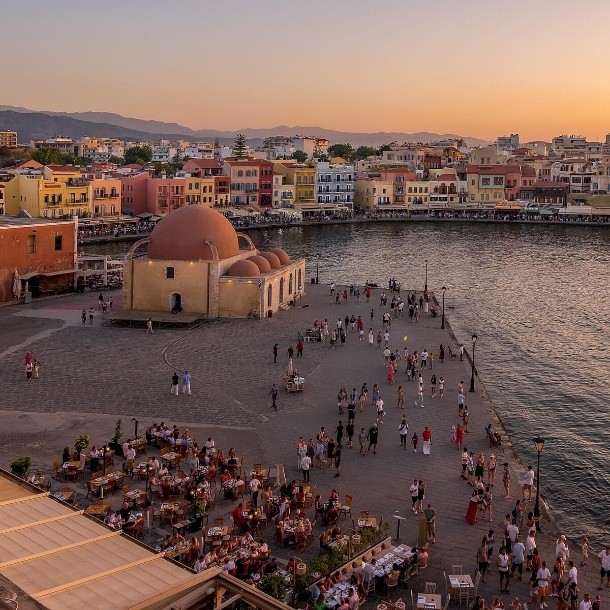Location



The island of Crete (also seen as Kreta or Kriti) is the most versatile and exciting destination in Greece. Crete is the largest Greek island and a landmark in the maritime crossroads between the West and the East, Europe and Africa, a unique and fascinating place full of transitions and surprises. The natural beauty and exquisite archaeological sites, the genuine hospitality, the pristine beach with crystal clear waters and the scrumptious and healthy cuisine offers visitors unique experiences.
In Crete, at the Diktaion Andron Cave in Lassithi Plateau, lies the birthplace of Zeus, the ruler of the gods, people and hospitality. Τhe hospitality of the Cretans is more than a ritual. The first European civilization, the Minoans, emerged here between 2800 BC and 1400 BC. Even today, the palaces of Knossos, Phaestus, Malia and Zakros reflect the splendor of the Minoan civilization through the masterpieces of architecture, pottery, gold, silversmithing and painting. The most powerful fleet in the then known world, as evidenced by the different findings across the Mediterranean, brought wealth to Crete from trading the famous Cretan cypress and its agricultural products. This brilliant course was terminated in 1400 BC when the Achaeans and the Dorians made their presence on the island, founding new towns (eg Lato, Polyrhenea) and gave the baton to the Classical Greek civilization.
The Prefecture of Chania, on the western side of the island, is dominated by the impressive White Mountains (Lefka Ori), the largest mountain range in Crete with more than 50 summits with a height over 2000 m. These mountains and its famous National Park of Samaria Gorge (the longest gorge in Europe with a total length of 16 km), which occupy the largest part of the region, provide tourist services and activities of all kinds. A city of many tales, ancient, old and contemporary, Greek and yet not only. Chania is one of the most appealing and worldwide popular tourist destinations of Greece, attracting every year, all year round, thousands of visitors and faithful lovers who repeatedly return to this mistress/city that has been so generously blessed by nature and densely woven by history. The city of Chania counts more than 140.000 residents. Since the construction of the Minoan city/state “Kydonia”, the city counts 4.000 years of presence in the Greek territory. For as long as there are historical records, Chania, has been a pole of attraction for political forces, economic interests and commercial exchange.
More information about the island of Crete can be found below.
Region of Crete: Incredible Crete
Greek National Tourism Organization: Visit Crete
Chania Tourism: https://www.chaniatourism.gr/
What to See
Chania’s old town is built around the Venetian port and is also a relatively integral area where Venetian buildings and later Turkish elements compose a unique architectural style. Stroll along the esplanade and by the old port and find yourself lost into the network of old city alleys. Due to the historic center of Chania with its Venetian walls defining the borders between the old and new city and its ramparts, the city has been pronounced as preserved. It consists of five connected districts surrounding the Venetian port. The Lighthouse is located at the end of the rock protecting the port from the north. It was built in 1570 by the Venetians and reconstructed in 1830 by the Egyptians and from there on preserves its current state.

Where to Swim
The beach of Balos, ranked 35th among the 100 World’s best beaches, is by itself a worthy reason to visit Chania. The Falasarna beach and the Elafonisi peninsula lying at the west coast of Crete also attract millions of sea-lovers each year.

What to Taste
Chania is the ultimate food lovers paradise. Don’t leave Crete without tasting "bougatsa" with cream, a delicious cream pie dusted with powdered sugar based on an old Asia Minor recipe; the small but very delicious olives (known as "psilelies"); the extra virgin-oil; the Cretan wines made from ancient varieties (including Vilana, Vidiano etc.); the Cretan "Anthotyros" cheese from Sfakia (fresh, soft, white cheese made of either sheep’s or goat’s milk); the Cretan "kalitsounia" (fresh cheese pie with herbs and greens); snails cooked in many different ways; charcuterie such as apaki; "tsikoudia", a fragrant grape-based distillate that follows or precedes every meal; "Dakos", a Cretan salad made traditional hard Cretan bread accompanied with tomato and "myzithra" (local cheese); sea food delights – special ingredients blended in delicious sea-urchin salads or divine fish soups.

